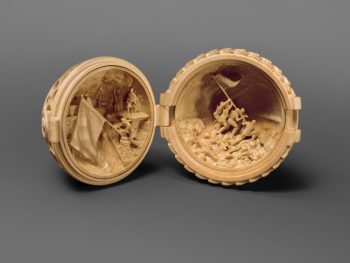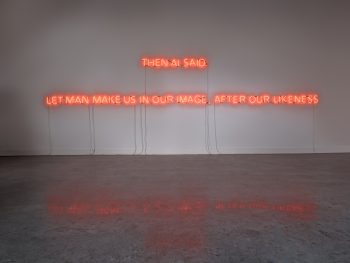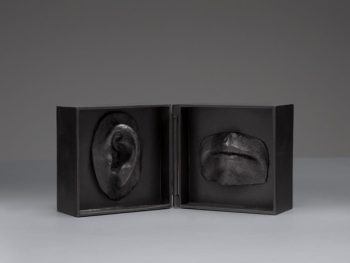Caspar Berger makes conceptual art in which current events and the art historical canon play a major role. The self-portrait and his own body are often the starting point for works of art in which themes such as freedom, mortality and political (belief) systems play an important role. Berger uses a wide variety of materials, including bronze, silver, gold, silicone, epoxy, wood and felt, but also video and multimedia or a combination of these. Caspar Berger’s oeuvre is divided into a series of extensive series; themes in these are: Skin, Skeleton, Universe and Spirit.
In Skin, the starting point is human skin. The skin defines the
boundary between the internal body of the personal ‘I’ and the impersonal of the external world. For Skeleton, Berger created an exact 3D copy of his skeleton in 2012 using a CT scan. Our ‘eternal’ identity, the identity that can still tell us something about who we were after our death, is the starting point. In Universe, Berger focuses on the space that humans occupy in social and political situations. Who are we in relation to our physical, social and political space and how does our unique identity relate to the collective fantasies that have shaped us. And in Spirit, the most recently started series of projects, Berger explores the theme of the attitude to life and life questions that arise from human shortcomings. Not only the superhuman meaning of Spirit applies here, but also the mental attitude that one can adopt in our social, political and societal environment.
Berger was born in Utrecht, the Netherlands, on January 24, 1965. He studied Plastic and Spatial Forms at the AKI in Enschede from 1984 to 1990. There he was taught by Maja van Hall, Ad Gerritse, Albert van der Weide, Helen Frik, and Hans Ebeling Koning, among others. Not classical sculpture but the composition of an image was central here. Berger made mixed-media work of abstract constructions in combination with video. During his post-academic period at the Jan van Eyck Academy in Maastricht, from 1990 to 1992, he was inspired by the work of video artists such as Bill Viola, Bruce Nauman and Nam June Paik.
Influenced by his admiration for the Italian High Renaissance, he then chose sculpture. Under the influence of his former teacher Ad Gerritse, there is a renewed interest in figurative art with a conceptual meaning. In 2007, his first solo museum retrospective opened in the Netherlands in the Beelden aan Zee museum in The Hague-Scheveningen, paving the way for a wider audience. There he exhibited a wide range of works, including his version of a Pietà, as a monument to all mothers with dead sons, a work based on Michelangelo’s version of the grieving Mary with her crucified son in her arms, one of the most perfect sculptures in art history. The work Family was also on display there, a tribute to the social group you are born into with the power structures that belong to the concept of family. With the deliberately ‘affected’ appearance, Berger puts his position in perspective compared to sculptors such as Cellini and Michelangelo, whom he considers his most important examples in art history.
Berger’s works are in various Dutch museum collections such as the Beelden aan Zee museum in The Hague-Scheveningen, the Rijksmuseum Amsterdam, the Singer Laren museum, and in corporate collections such as the ING Collection and the Achmea Art Collection. Abroad, for example, in the Fundació NUMA – Espais de Cultura, (Spain) Menorca, Spain, the Katrin Bellinger Collection and the municipality of Bad Homburg. Berger also created various large commissioned works. His work was awarded the Singer Prize 2013 and the Sacha Tanja Penning 2014.
Photography works: Erik and Petra Hesmerg






